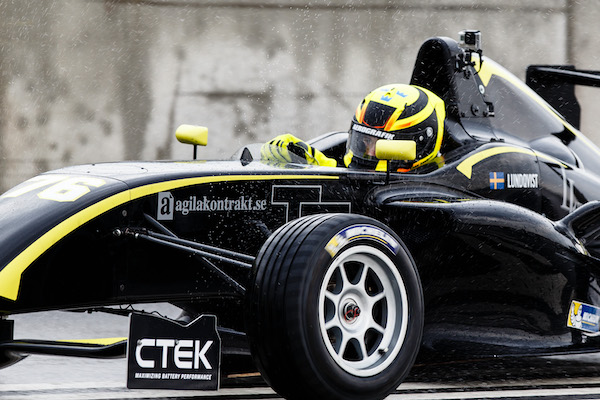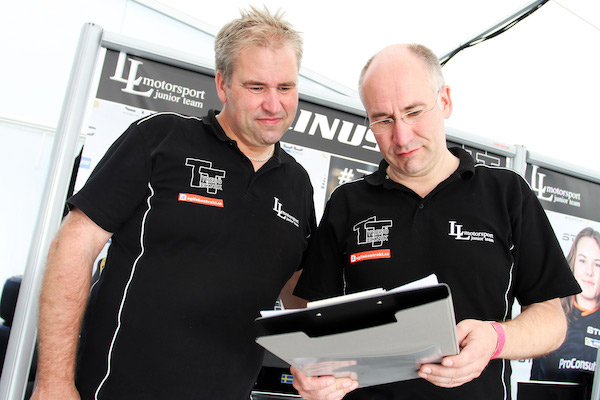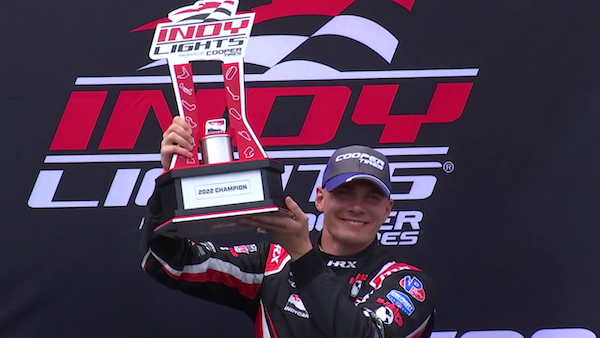Learn about purchasing for teams
Agile Racing: Linus Lundqvist's Journey to Formula Championship

The air is charged with excitement and a palpable blend of the acrid scent of engine fuel mingled with the staccato rhythm of pneumatic wrenches and the occasional murmurings of mechanics. Vibrations resonate through the ground as engines start to roar to life, and high-octane adrenaline begins coursing through Agile Racer Linus Lundqvist's every vein.
"The minutes and hours leading up to a race are probably the worst," Linus said. "You're so nervous. There’s all this pressure, all this excitement, and you have to stay focused because you know what it means—what a good result could possibly lead to and what a bad result could possibly lead to. It takes so little to make a mistake. In racing, a mistake usually means that you crash at a pretty high speed. So not only might you get hurt, but you also just throw away a good result—and it'll cost you a lot of money."
But with agile principles in practice, once Linus takes the wheel, the rollercoaster of emotions fades away. "As soon as you put your helmet on, the world outside disappears. You focus solely on the task at hand—racing as hard as you can,” Linus said.

Improve Mindsets and Methods, and Results Will Follow
Linus’s team is made up of highly specialized members such as race engineers, strategists, and mechanics. With a shared passion for continuous improvement, not to mention winning races, they were open to new ideas. Still, introducing agile and lean techniques typically associated with software development teams to racing was unexpected in an institution dominated by tradition. But Bo "Bosse" Hanner, race engineer for the team, witnessed agile and lean practices greatly accelerate progress through his work at Scania, a renowned truck manufacturer, and was confident that the process could easily translate to racing.
At its core, agile is a set of principles centered around continuous improvement; scrum is one of several agile frameworks. At the heart of scrum is dividing the work into brief time intervals called sprints, which provides more chances for the team to review what’s working and what’s not to keep advancing.
"It wasn't that we actively sought out agile,” said Linus. “It was more a question of how we could win a championship. What's our method? We tested it, saw success, and adapted it for our race team. We quickly realized it was the best tool for the job. Racing might be different from other industries, but the mindset and questions you ask are remarkably similar."
Forging a New Path Through Continuous Improvement
Beginning his racing journey in carting in the summer of 2007 at just eight years old, Linus won the local series in Formula Micro in 2010—repeating that victory one year later in the bigger Formula Mini category. From there, he soon found himself in the Formula STCC Nordic series finishing fourth. Although the average rookie would be thrilled, the team knew another year like that could end Linus’s career before it truly started. Formula racing is extraordinarily expensive and he was from everyday means. This meant there was an extremely small margin for error in this new season. Enter agile.
With so many variables on and off the racetrack, it can feel that ambiguity, uncertainty, and change are the only constants. With agile, ambiguity is tamed, the "why" for every team member becomes crystal clear, and results are paramount. Linus won his initial race in that series.
“The race team made three major mindset shifts,” said team mentor and Product Development Specialist Mattias Skarin. “First, we shifted from focusing solely on results to improving the methods by which the team worked. Second, we understood that everyone, not just key roles, needed to improve continually. Lastly, we moved from attributing outcomes to luck to adopting a systematic, data-driven approach."
One of the seemingly small changes that sprouted into pivotal results is that of their mechanics' checklist. "We provided them with checklists and notes for car changes,” said Bosse. “At the beginning of the season, it was a blank sheet, but by the end of the year, it had grown into a four-page checklist." This checklist, in some ways, is a lot like a definition of done, supporting collaboration and engagement on the team. The checklist continued to evolve along with the needs of the team.

By systematically adding necessary tasks to the list in the order needed on the car, they created a natural flow for the mechanics resulting in fewer unnecessary shifts of tools and fewer mistakes—more done in less time and with better results.
Sprint or Typical Race Weekend? Both.
"From an agile perspective, a race weekend is a natural sprint,” said Mattias. “It follows a similar cycle—plan, execute, demo, and retrospect. The key difference is the rapid feedback cycles in racing, where decisions must be made quickly."
After initial prep leading into the weekend, it’s during two practice sessions that the team can explore and test theories. The challenge, of course, is to improve and adapt better and faster than the competition during the qualifying event and the race itself.
“We go into each race with the feeling of we haven't left any stones unturned,” said Linus. “We've done everything possible and we've done extremely well in terms of preparation. And that just fills you with confidence.”
That confidence also allows team members to stay cool under pressure. During a qualifying run, Linus faced an unexpected situation. He was called into the pits with minutes left in the session. Most drivers would have panicked, but Linus stayed calm. He talked with the race engineer, left the pits, and then set the two fastest laps of the qualifying run.
"Our methods give us the capacity to handle surprises calmly,” said Linus. “When obstacles come our way, we don't panic; we adapt. It was our preparation that puts us in the right state of mind to tackle any challenge. The team's calm and collective approach is invaluable."
A systematic approach to identifying the hidden opportunities has also set this team apart in an extremely competitive field.
"We challenge old truths and question if what’s worked in the past is still valid,” said Linus. “We take nothing for granted. While other teams accept certain practices as truth, we dig deeper, questioning their validity."

Ready for Anything
No journey is without its setbacks, and Linus and his team encountered their fair share. Having an agile state of mind keeps the focus solution-oriented, illustrating the boundless potential of innovative thinking at its true transformative power.
"We took a hard look at ourselves and our performance,” said Linus. “We don't brush setbacks off as bad luck. Instead, we examined the data, asking if a setback is truly out of our control. Even in instances of bad luck, we asked ourselves if we could have done better, and how."
Even when something is outside of their control, the team stays on track and ready to pivot. In 2022, Linus’s Indy Light scholarship was reduced by 60%, practically eliminating his opportunity to drive a set of races in IndyCar. Even though it was a major setback for Linus and every person supporting him, the team didn’t give up hope.
“Knowing that no other team is as well-prepared or has done as much work or put in as much effort as we have just helps your state of mind,” said Linus. “You feel a bit more confidence in both your own abilities but also the whole team around you.”
It shows. In 2023, Linus found himself joining the legendary Chip Ganassi Racing in the IndyCar series. Through this remarkable journey, Linus’s tight-knit team has shown that even the most unconventional applications of well-established agile practices can lead to unprecedented success.
What’s next for this agile racer, Linus Linus Lundqvist? Strap in and watch the ride.
Follow Linus on his continuing agile journey. Subscribe to the Linus Lundqvist newsletter for updates.
Also, sign up for Scrum Alliance emails to get more inspiring tales of scrum in action sent directly to your inbox!











